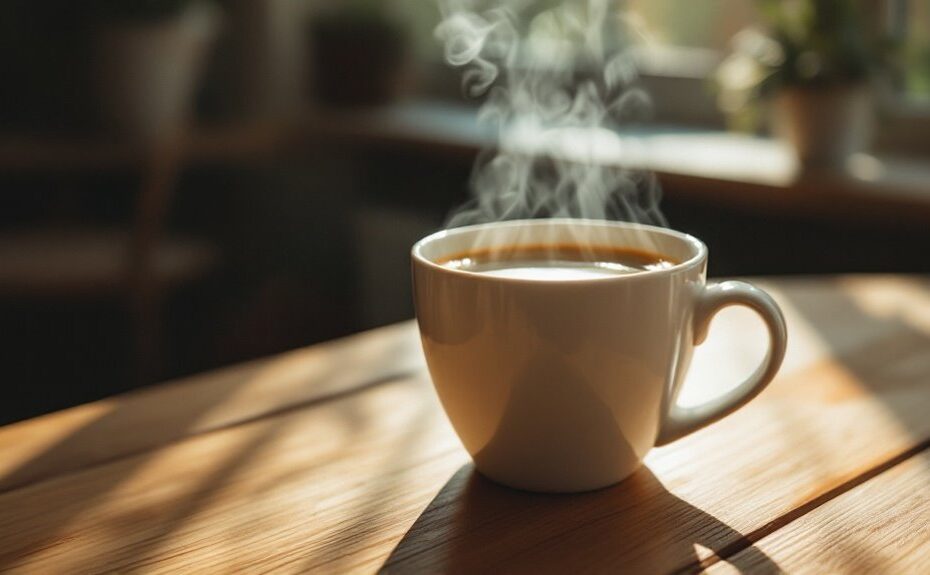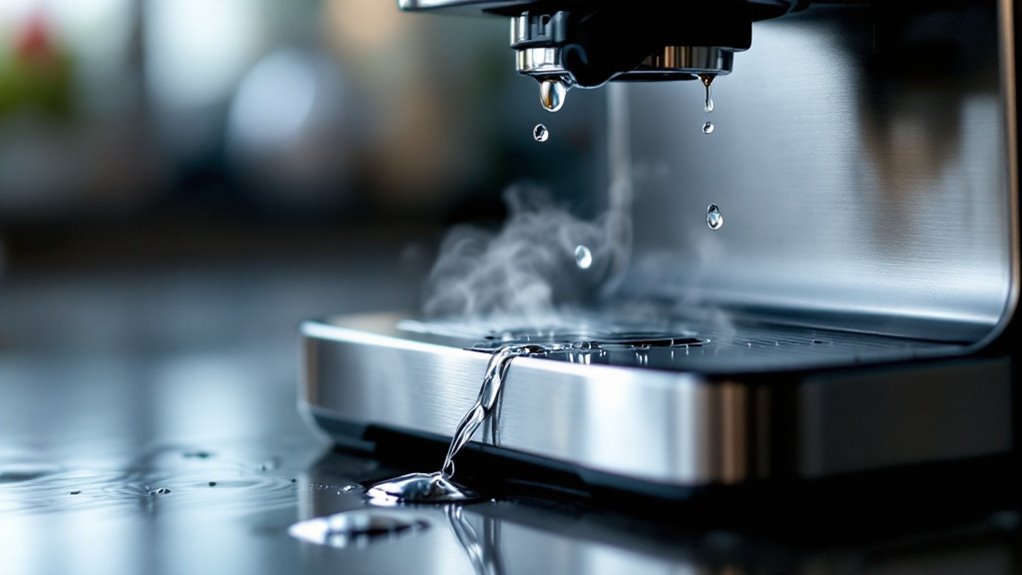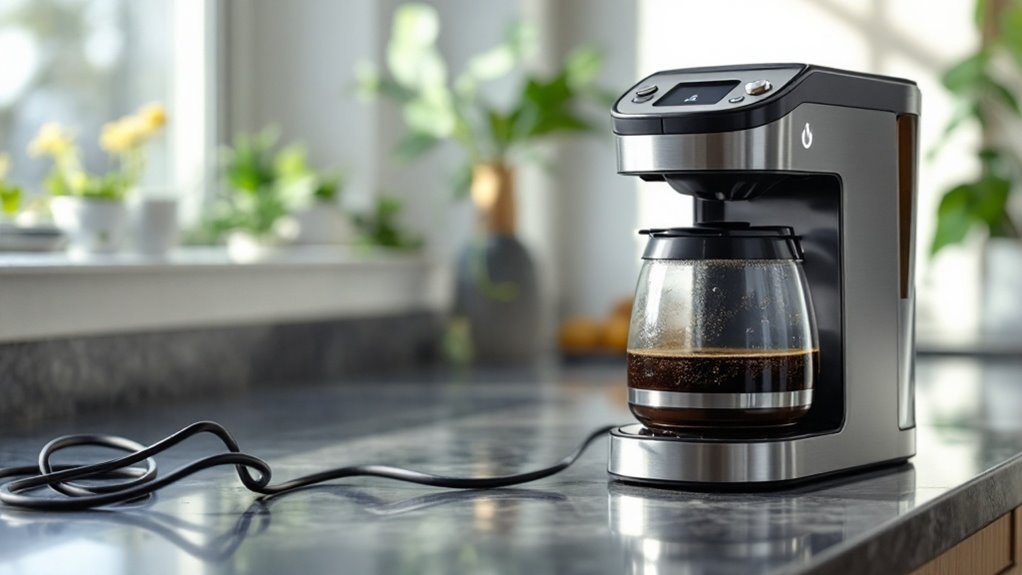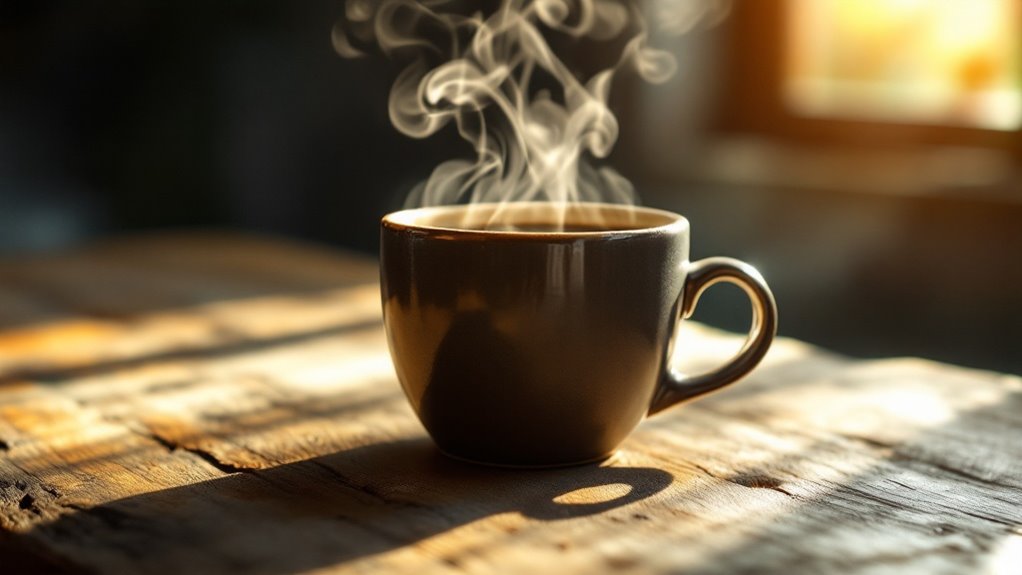







A steaming cup of coffee is more than a morning ritual—it's a promise of warmth and energy. But when that first sip feels lukewarm, it's a letdown that leaves you questioning your setup. Is it your machine struggling to heat properly, or are you unknowingly sabotaging the process with cold cups or hard water? The answer might lie in overlooked details, from mineral buildup to brewing habits. Uncover the hidden factors that could be cooling your coffee and discover how small adjustments can reignite the heat you crave. The solution is closer than you think.
Key Takeaways
- Mineral buildup from hard water can insulate the heating element, reducing its efficiency and causing lukewarm coffee.
- Overfilling the water reservoir or using cold water strains the heating element, making it harder to reach optimal brewing temperatures.
- A malfunctioning heating element or thermostat may fail to heat water to the ideal range of 195-205°F (90-96°C).
- Failure to preheat the coffee machine or cups leads to heat loss, resulting in cooler coffee during brewing and serving.
- Using uninsulated or thin containers accelerates heat loss, while double-walled or thermal mugs help retain warmth longer.
Common Causes of Lukewarm Coffee
When brewing coffee, one of the most frustrating issues you might encounter is lukewarm coffee. This often stems from problems with the heating element, which is responsible for raising the temperature of the water to the ideal 195-205°F range. If the heating element is malfunctioning or weakened by limescale buildup, it won't generate enough heat to produce hot water. Limescale, a common issue in areas with hard water, accumulates over time and insulates the heating element, reducing its efficiency. As a result, the water may not reach the required temperature, leaving your coffee tepid.
Another factor is the quality of the water you use. Cold or room-temperature water entering the machine can strain the heating element, making it harder to achieve consistent hot water. Overfilling the water reservoir can also disrupt the heating process, as the machine may struggle to heat excessive amounts of water evenly. Additionally, failing to preheat your coffee machine or cups can cause heat loss, further contributing to lukewarm coffee. These issues, while common, are often preventable with proper maintenance and usage habits.
How to Test and Diagnose Heating Issues
If your coffee isn't reaching the ideal temperature, testing and diagnosing heating issues can help pinpoint the problem. Start by measuring the water temperature directly from the portafilter or brew head using a thermometer. The water should be between 195-205°F (90-96°C) for peak extraction. If it's below this range, the heating element or thermostat may be faulty. Use a multimeter to check the heating element and thermostat for continuity, verifying they're functioning correctly.
Next, test the machine's rinse cycle to confirm it dispenses hot water (around 1 oz or 30 mL) and effectively preheats the brewing unit. If the water isn't hot enough during this cycle, the issue may lie with the internal heating system. Additionally, inspect the warming plate or thermal carafe to confirm it maintains the desired temperature.
Finally, monitor the coffee temperature during brewing and serving. Small shot volumes or unheated cups can cause rapid cooling. If inconsistencies persist, focus on the heating components, as they're critical for maintaining hot water and delivering properly heated coffee.
Effective Descaling and Cleaning Methods
To prevent mineral buildup from affecting your coffee maker's heating efficiency, use a descaling solution or a 1:1 mixture of white vinegar and water. Run a descaling cycle every 1-3 months, adjusting based on water hardness, to guarantee steady performance. Clean removable components like the carafe and filter basket with warm, soapy water to avoid residue accumulation and maintain peak functionality.
Preventing Mineral Buildup
Mineral buildup in your coffee maker can greatly impact its heating efficiency, leading to lukewarm coffee. To prevent this, you must address the quality of the water to brew your coffee. Hard water, rich in calcium and magnesium, is the primary culprit behind limescale deposits. These deposits accumulate on heating elements and internal components, reducing heat transfer and slowing the brewing process. Using filtered or softened water markedly reduces mineral content, minimizing buildup and maintaining your coffee maker's performance.
Regularly inspect the water reservoir and internal components for visible mineral deposits. If you notice chalky residue, clean it promptly to prevent further accumulation. While descaling is essential, preventive measures like using high-quality water can extend the time between descaling cycles. Always follow the manufacturer's guidelines for cleaning and maintenance to avoid damaging sensitive parts, such as seals or heating elements. By proactively managing mineral buildup, you'll guarantee your coffee maker operates efficiently, delivering consistently hot coffee.
Proper Descaling Techniques
Descaling your coffee maker is a necessary step to maintain its heating efficiency and guarantee your coffee stays hot. To descale drip coffee makers effectively, use a descaling solution or a mixture of one part white vinegar to two parts water. This solution dissolves mineral buildup that accumulates over time, which can clog internal components and reduce heating performance. Follow the manufacturer's instructions to run the descaling cycle, typically every 1-3 months, depending on your water's hardness. Avoid using harsh chemicals or undiluted vinegar, as they can damage seals and internal parts. After descaling, run multiple rinse cycles with clean water to eliminate any residual solution or vinegar taste. Regular descaling not only prevents clogs but also secures your drip coffee maker operates at peak efficiency, keeping your coffee hot and extending the machine's lifespan. By incorporating this maintenance routine, you'll maintain ideal brewing temperatures and enjoy consistently hot coffee.
Tips for Maintaining Optimal Brewing Temperature
For maintaining the ideal brewing temperature, preheating your coffee cups with hot water can substantially reduce heat loss during serving. This simple step guarantees your coffee stays closer to the ideal serving temperature of 160-185°F. When brewing, always use a thermometer to confirm your water temperature falls within the 195-205°F range, as this is critical for proper extraction and flavor development. If your coffee pot includes a warming plate, make sure it's functioning correctly and set to a moderate temperature to avoid overheating, which can degrade flavor. Regularly descale your coffee maker to prevent mineral buildup, which can impede heat transfer and reduce brewing efficiency. For consistent results, consider investing in a coffee maker with Specialty Coffee Association (SCA) certification, as these machines are designed to maintain precise brewing temperatures. Additionally, place your coffee maker in a warm environment or use a mug warmer to keep your coffee at an ideal serving temperature longer. By combining these practices, you'll maximize heat retention and guarantee your coffee stays hot and flavorful from the first sip to the last.
Troubleshooting Machine-Specific Problems
When troubleshooting machine-specific issues, start by identifying the root cause of your coffee's insufficient temperature. If your Keurig Duo isn't making your coffee hot enough, check the heating element for malfunctions, as a faulty component can result in lukewarm brews. For Cuisinart Coffee Center SS15 users, inspect the thermal carafe for cracks or broken seals, which can lead to significant heat loss. If your Bunn coffee maker isn't heating properly, verify the thermostat settings, as incorrect configurations may prevent the water from reaching the ideal temperature. Delonghi espresso maker owners should confirm the water flow and valve functionality are intact, as blockages can disrupt the brewing process and reduce heat. Additionally, descale your machine regularly, especially if you have hard water, as mineral buildup can impair heating efficiency and prevent your coffee from staying hot enough. By addressing these machine-specific issues, you can pinpoint the problem and restore your coffee's perfect temperature.
Upgrading Your Coffee Setup for Better Heat Retention
If troubleshooting your coffee maker hasn't resolved the issue of lukewarm coffee, upgrading your setup can substantially improve heat retention. Start by investing in a thermal carafe coffee maker, which maintains new coffee at 175-185°F for hours, unlike glass carafes that lose heat rapidly. Pair this with double-walled stainless steel mugs or vacuum-insulated tumblers, which can keep your coffee hot for 6-12 hours. Before brewing, preheat your cup with plain water to minimize heat loss when the coffee contacts a cold surface. For peak brewing, upgrade to an SCA-certified coffee maker, such as the Moccamaster, which guarantees water reaches the ideal temperature of 195-205°F, enhancing both flavor and heat retention. If precision is key, consider a smart mug like the Ember, which lets you set and maintain your coffee temperature between 120-145°F. These upgrades not only preserve heat but also elevate your coffee experience by guaranteeing every sip stays at the perfect temperature. By focusing on better insulation and precise temperature control, you can enjoy consistently hot coffee without compromise.
Disclosure: As an Amazon Associate, I earn from qualifying purchases.





